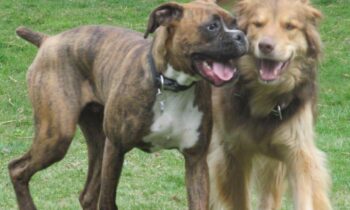
Do you know an adult dog that has never been housetrained? Maybe the dog lives with a friend of yours, a family member, a neighbor? Or … does the dog live with you? It can’t be pleasant, sharing a home with a dog who eliminates freely in that home. It’s smelly, it’s unhealthy, and it’s embarrassing.
Not all adult dogs that aren’t housetrained are “pandemic pups,” adopted during the lockdown, but some certainly are: I’ve been told about several of them myself. Whatever the reason, there are and always have been adult dogs who’ve never had the chance to learn to eliminate outside as a preference, instead of inside as a convenience. Those dogs can learn to be housetrained.
I asked dog professionals about their experiences with unhousetrained adult dogs, either their own dog, a friend’s or client’s dog, or dogs they’ve fostered.
Colette Kase (Mexico) The most common times I encountered this with clients was in three main scenarios. First, with dogs trained to go inside on paper or pads and the owner is unable to transition the dog to eliminating outside. Second, in multiple-dog households, where dogs would copy each other. Third, in very large homes where a dog would sneak off to other areas of the house; that was usually compounded with punishment, so the dog would hold it on walks and wait to get home and hide while doing it. That’s far more common in small dogs.
Outcome was often poor as the owners had lived with the problem for a very long time and were unwilling to do the necessary work, inconvenience themselves, or make the necessary changes. In fact, if they had been willing to do the work in the first place, they wouldn’t have the problem.
The most likely situation for a positive outcome was in the cases where punishment had been used and the owner had an “Aha!” moment as a result of our consultation. With good management combined with relationship-building with their owners, these dogs could be easily housetrained, as they already had the ability to hold it and to choose locations that they found beneficial. Once rewards were involved, the dog was happy to comply. The owners often felt very guilty, which seemed to motivate them to do the work.

Photo by Amy Suggars
I asked Colette to explain how a dog learns ‘how to hold it’ and why that’s so important.
Colette Kase: As puppies grow, so does their central nervous system and the signals that tell them when they need to toilet. That’s when bladder and bowel control develop and they recognize the signals that tell them to eliminate. Learning to ‘hold it’ is a skill that is necessary and natural. There are times and locations when toileting is appropriate, and as dogs learn when those times are and where those locations are, they learn to prevent themselves from toileting. It can take a while to develop these skills and muscles, called sphincters.
While it is not healthy to expect puppies or adult dogs to hold it for very long periods of time, they can learn to do so quite early on, along with indicating that they need to toilet, and try to hold it for up to an hour at about ten weeks of age. Of course, this will vary depending on the size of the dog, activity level, and also how much water they consume. A rough estimate is from twelve weeks—when most puppies can hold it for up to two hours (if trained to do so)—they can hold it for an additional hour per month until they are six months old. At this time, a puppy may even be able to hold it for up to eight hours.
We can teach puppies to hold it by keeping them closely supervised at the times that we know they are likely to need to eliminate—after eating, drinking, sleeping, or playing. If we keep them on our lap, very close to us, or confined to their bed, we can gradually extend the length of time by a few minutes each day that we expect them to ‘hold it’ before giving them access to the toileting area that we are training them to use. If we combine that with a cue and high-value rewards for eliminating in the correct location, the puppy will start to actively seek to hold it in an effort to receive the reward.
Kate LaSala Ctc Csat (Connecticut) Housetraining issues can be super frustrating and really zap the joy out of having a new puppy or dog in your home. Nobody likes to clean up constant messes or live with pee and poop. Luckily, there are a few key things you can do to get your pup on the right track for housetraining success. And also a few things not to do!
Honestly, [for adult dogs] it’s really all the same process. The only ones that I’ve found to be trickier are puppy-mill breeder dogs who have been crated extensively, usually have some degree of crate aversion, and are used to just [eliminating] in their crates. But the housetraining process is the same whether it’s adults or puppies or new rescues or whatever.
Margaret Tyler (Illinois) I housebreak adult dogs, my fosters who have lived in kennels all their lives, and it’s usually surprisingly easy if you put in the time and supervision, watch for signals, and establish a routine.
Many of these dogs do not trust/are afraid of people, so a fenced yard and good peripheral vision is helpful, because they don’t feel safe enough to go when you’re within leash range, and staring at them discourages them, too. Praise (quiet, if they are scared) and tossing a treat in front of them as they finish tells them going outside is a good thing to do.
Having at least one mentor dog helps, too, because they smell eliminations outside, but not inside.
While inside, if the dog gets up and starts to move away, it’s time to go out. After bedtime is seldom a problem, since usually they are confined to a smallish bedroom with me and my dogs, and adults (barring health problems) can hold it that long. And in bad weather, if the dog dislikes it (they get to decide what’s good or bad), [going back] inside can be the best reward!
Kat Camplin (California) Most of my clients actually had the start of potty training, but never [taught the dog] a signal for the human to open the door. Going to the door doesn’t get reinforced because the owner doesn’t notice it. Installing a potty bell or a nose nudge to the human fixes that broken link.
Alisha Ardiana (California) Typical issues I encounter with clients:
Expectations: I have a lot of people who want their dog to tell them they have to go out. That’s not realistic. Think back to when your kids were young: any time you go on a road trip, you remind them several times to go to the bathroom before you leave. What happens about 30 minutes into your trip? “Mom! I need to go to the bathroom!” We give kids years to work this out; how much time do we spend training dogs?
Solution: Just take the dog out. Stop waiting for them to tell you.
Frequency: The average dog needs to potty seven times in 24 hours. I often see people expect the dog to only need to go out morning, noon and night.
Solution: Try seven times a day and see if it helps.
Social need: People often want their dog to pee on a pad, the deck, patio, etc. Urine is hugely important for many dogs for communication and marking. Our dog pees at least three times on any walk. That’s her social time. We quickly let go of the expectation of her peeing on our deck.
Solution: Observe if your dog is a “one and done” for peeing or a social butterfly. Mark Beckoff wonders if little dogs pee more because it’s an easier form of communication vs. direct contact.
Substrate: Dogs learn as puppies what substrate is appropriate. If the dog had a history with a pee pad or grass, the transition to gravel or concrete could be difficult.
Solution: Try walking on different substrates to see what your dog prefers.
Behavior: If the dog lives in an urban environment, going to the bathroom could be hugely stressful. Is the dog able to potty safely without interruption? Is the walk free from fear and intimidation by unknown dogs and people?
Solution: Can you identify safer locations to walk? Even if it means getting in the car?
How long does it take to housetrain an adult dog reliably? Don’t believe the online ads that promise you can train a dog or puppy not to pee or poop in the house ever—in six days. It’s a lie.
Start simply, with a vet visit. An adult dog never housetrained; are any health issues involved? Plan the next steps of housetraining the dog with your goals firmly in mind.
Set your dog and yourself up for success. Get the whole household on board!
Reward the behavior you want, from the dog and from the humans in the dog’s life. It works!



